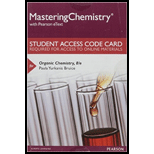
(a)
Interpretation:
The peptides obtained from the cleavage of given peptide chain by carboxypeptidase A has to be given.
Concept introduction:
Amino acids are linked each other by peptide bonds is called protein (one or more peptide bonds). Peptide bonds are amide bonds, in which carbonyl group of one amino acid bonded to amino group of other amino acid. The chain of the protein is drawn in such a way that left end is occupied by free amino group (say N-terminal) and right side of the chain is occupied by carbonyl group (say C-terminal).
Exopeptidases cleave peptide bonds that are not at the end.
Carboxypeptidase A is an exopeptidase, which cleave the peptide bond of C-terminal amino acid except arginine and lysine.
(b)
Interpretation:
The peptides obtained from the cleavage of given peptide chain by cyanogen bromide has to be given
Concept introduction:
Amino acids are linked each other by peptide bonds is called protein (one or more peptide bonds). Peptide bonds are amide bonds, in which carbonyl group of one amino acid bonded to amino group of other amino acid. The chain of the protein is drawn in such a way that left end is occupied by free amino group (say N-terminal) and right side of the chain is occupied by carbonyl group (say C-terminal).
Cyanogen bromide cleaves the C-terminal peptide of Methionine in a peptide chain.
(c)
Interpretation:
The peptides obtained from the cleavage of given peptide chain by trypsin has to be given.
Concept introduction:
Amino acids are linked each other by peptide bonds is called protein (one or more peptide bonds). Peptide bonds are amide bonds, in which carbonyl group of one amino acid bonded to amino group of other amino acid. The chain of the protein is drawn in such a way that left end is occupied by free amino group (say N-terminal) and right side of the chain is occupied by carbonyl group (say C-terminal).
Endopeptidases cleave peptide bonds that are not at the end.
Trypsin is an endopeptidase, which cleave the C-side peptide bond of positively charged side chains such as arginine and lysine.
Want to see the full answer?
Check out a sample textbook solution
Chapter 21 Solutions
Organic Chemistry Study Guide and Solutions Manual, Books a la Carte Edition (8th Edition)
- Draw the Fischer projection from the skeletal structure shown below. HO OH OH OH OH H Q Drawing Atoms, Bonds and Rings Charges I ☐ T HO H H OH HO I CH2OH H OH Drag H OH -CH2OH CHO -COOH Undo Reset Remove Donearrow_forwardplease provide the structure for this problem, thank youarrow_forwardpresented by Morallen Lig Intermine the hand product for the given mution by adding atoms, bonds, nonhonding diarion panda скуль Step 3: Comp the draw the product Step 2: Agama workup Compithe 429 ملولةarrow_forward
- Reaction A 0,0arrow_forwardpresented by Morillon Leaning Predict the organic product for the min кусур HSC Adithane carved arnown to come than that to the condon slchroruis in acid in in aquishri with ноюarrow_forward6.15PM Sun Mar 30 K Draw the major product of this reaction. Include any relevant stereochemistry. Ignore inorganic byproducts. Problem 1 of O H [PhзPCH2CH3]*C|¯ NaH Drawing > Q Atoms, Bonds and Draw or tap a nearrow_forward
- 8:17 PM Sun Mar 30 Draw the major product of this reaction. Ignore inorganic byproducts. HSCH2CH2CH2SH, BF3 Probler Drawing Ato Bonds Clarrow_forwardpresented by Mr L How the coprion. (Il Done in no wraction, dew the starting redential) доarrow_forward8:16 PM Sun Mar 30 K Draw the major product of this reaction. Ignore inorganic byproducts. Proble 1. CH3MgBr 2. H3O+ F Drawingarrow_forward
- о но оarrow_forwardName the major organic product of the following action of 4-chloro-4-methyl-1-pentanol in neutral pollution 10+ Now the product. The product has a molecular formula f b. In a singly hain, the starting, material again converts into a secule with the molecular kormula CIO. but with comply Draw the major organic structure inhalationarrow_forwardMacmillan Learning Alcohols can be oxidized by chromic acid derivatives. One such reagent is pyridinium chlorochromate, (C,H,NH*)(CICTO3), commonly known as PCC. Draw the proposed (neutral) intermediate and the organic product in the oxidation of 1-butanol by PCC when carried out in an anhydrous solvent such as CH₂C₁₂. PCC Intermediate OH CH2Cl2 Draw the intermediate. Select Draw Templates More с H Cr о Product Draw the product. Erase Select Draw Templates More H о Erasearrow_forward
